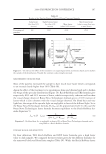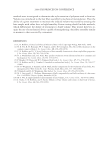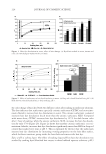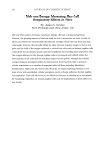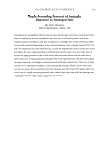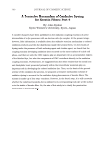JOURNAL OF COSMETIC SCIENCE 148 Figure 4 that both shampoos reduce the amount of broken fi bers signifi cantly by 49% and 69%. These effects are even improved when using both, shampoo and conditioner reaching a nearly 90% hair breakage reduction. Interestingly, the shampoo containing 3% dimethicone was less effective when compared to the other shampoo with only 1.4% dimethicone. DEVELOPMENT OF AN ALTERNATIVE ANTI-BREAKAGE SHAMPOO INGREDIENT In a screening test, several parameters were tested on their infl uence on the deposition of waxes on hair from a shampoo: O Chemistry O Hydrophilicity/hydrophobicity O Particle size O Hair state (virgin/bleached) O Cationic polymer in the shampoo O Concentration of the wax in the shampoo Out of these series, the particle size was found to be the most signifi cant parameter. Therefore, our objective was to develop a wax dispersion with particles smaller than 1 μm. Ether chemistry was chosen to ensure hydrolytic stability over a wide pH range, al- lowing the use in different fi elds like bleaching, perming or hair straightening. Finally, a compound consisting of PEG-4 distearyl ether, distearyl ether and dicaprylyl ether dis- persed in sodium laureth sulfate was developed. The effi cacy of this ingredient was tested in shampoos with increasing concentrations of the wax dispersion combined with guar hydroxypropyltrimonium chloride. The compo- sition of the shampoos can be found in Table I. In Figure 5 the anti-breakage effi cacy of shampoos containing 1, 2, 3 and 4% dispersions (equal to 0.25–1% active matter of the wax) is compared with the effect of a placebo con- taining a styrene/acrylates copolymer as turbidity ingredient. The shampoo composition is given in Table I. A clear dependence on the dosage was found. By comparing the levels of Table I Tested Shampoo Compositions Placebo Shampoos with active Sodium laureth sulfate 10 10 Cocoamidopropyl betaine 3 3 PEG-4 distearyl ether (and) sodium laureth sulfate (and) distearyl ether (and) dicaprylyl ether 1−4 (equals 0.25 to 1% wax) Styrene/acrylates copolymer (and) cocoglucoside 0.4 (equals 0,12% wax) Guar hydroxypropyltrimonium chloride 0.2 0.2 Laureth-2 1 1 Citric acid pH adjustment to pH 5 Sodium chloride Viscosity adjustment Perfume 0.3 0.3 Preservative 0.5 0.5 Water Add to 100%
2008 TRI/PRINCETON CONFERENCE 149 hair breakage with those of strands treated with market shampoos (Figure 4), it can be seen that a concentration of 2% in the shampoo shows a similar protection compared to the benchmarks. The shampoos with concentrations of 3 and 4% wax dispersion even reached the same protection level as the combination of shampoos and conditioners (90% reduction of hair breakage compared to only bleached hair without further treatment). The wet and dry hair conditioning performances of the shampoos containing the wax dispersion was tested in comparison to the benchmark shampoos. The results are shown in Figure 6 and Figure 7. Interestingly, while the wet combing performance of the sham- poos with higher contents of wax reaches those of the market shampoos, the latter are a little more effi cient in terms of dry combing. This is in contrast to the anti-breakage performance. Obviously, low hair breakage is not completely in line with a good dry combability. This might be due to additional effects in the anti-breakage test which will be further discussed in the conclusions of this paper. To have a closer look to the dosage dependency of the anti-breakage performance in sham- poos the amount of wax deposited on the hair after several shampooing cycles have been determined by GC analytics of hair strands extracts. The results are shown in Figure 8. A clear dosage dependency can be seen in these data, as well as some build-up effects. CONCLUSIONS We were able to show that tailor-made wax dispersions formulated in shampoos with a cationic polymer are at least equally effi cient as silicones in reducing hair breakage and split ends. The results of combability experiments and hair breakage tests are completely parallel with the silicone containing shampoos and the shampoos containing the wax dispersion. Most probably the reason can be found in a different underlying mechanism. Figure 5. Hair breakage for hair strands treated with shampoos containing varying concentrations of an ether-based wax dispersion. All results except for the difference between 3% and 4% of the wax dispersion are signifi cantly different (p0.05).
Purchased for the exclusive use of nofirst nolast (unknown) From: SCC Media Library & Resource Center (library.scconline.org)














































































